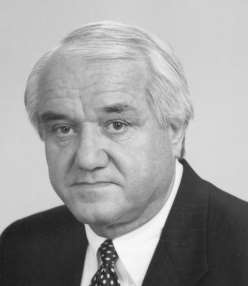Breadcrumb
- Home
- About
- Iowa Geode Stars
- Marcus Milling
Marcus Milling (1938-2006)

Marcus Eugene Milling was born in Texas on October 8, 1938. As an undergraduate, he attended Lamar University in Beaumont, TX, receiving a BS in geology in 1961. He attended graduate school at the University of Iowa, receiving an MS in 1964 and a PhD in 1968. He worked under Sherwood Tuttle on stream morphology and glacial tills.
Marcus was married to Sandra, and they had one son, Mark.
Upon completion of his PhD, Marcus went to work for Exxon Production Research, working on deepwater deposition. His areas of expertise became hydrocarbon basin assessment, seismic stratigraphic sequence analysis, reservoir characterization, and technical program management. In 1977, he moved (within Exxon) from research to operations in south Texas and the Gulf of Mexico.
In 1980, Marcus joined ARCO as the general manager of the Geological Research Group at the central R & D facility in Plano. He subsequently became ARCO’s chief geologist, managing the exploration staff.
In 1987, he became the associate director of the University of Texas – Austin’s Bureau of Economic Geology. He coordinated oil and gas consortia programs, as well as environmental and water resource investigations. In 1987 and 1988, he was program director for the High-level Nuclear Waste Isolation Program.
In 1992, he became the executive director of the American Geological Institute (now the American Geosciences Institute). In that capacity, he was responsible for directing information, education, publication, and government affairs programs. He is credited with leading the Institute out of financial difficulties and doubling its size.
“Under Milling’s leadership, AGI improved geoscience education through initiatives ranging from research projects to Earth Science Week, increased the role of the geosciences in political processes with the creation of the Government Affairs Program, and expanded the Georef bibiliographic database and other key information services. Milling was an exceptional leader who made great strides in raising geoscientific awareness for education, government, and the public throughout his career. And he channeled his greatest aspirations for the geoscience community into AGI” (Camphire, 2019).
Marcus Milling led the AGI until his passing on October 17, 2006. In 2007, the AGI renamed its Legendary Geoscientist Award in his honor, as the Marcus Milling Legendary Geoscientist Medal.
Marcus was active in many facets of his profession. He was a vice-chair of the Offshore Technology Conference’s Board of Directors. He was a member of the U. S. Department of Energy’s Research Advisory Board on Solid Earth Sciences, and served on the National Academy of Science’s Continental Scientific Drilling Committee. He was a councilor with the Geological Society of America, and a member of the American Association of Petroleum Geologists since1966, where he served on several committees and was associate editor of the Bulletin from 1982 to 1985. He received AAPG’s Special Award posthumously in 2007.
Marcus was also awarded the American Institute of Professional Geologists’ Ben H. Parker Memorial Medal in 1997, and the Association of American State Geologists’ Pick and Gavel Award in 2005.
In His Own Words
- Milling, M. E., and Tuttle, S. D., 1964, Morphometric study of two drainage basins near Iowa City, Iowa: Iowa Acad. Sci., v. 69, p. 304-311.
- Milling, M. E., 1968, Petrology and petrography of glacial tills and their weathering profiles in southeastern Iowa: dissertation, Univ. Iowa.
- Tuttle, S. D., Milling, M. E., and Rusnak, R. S., 1968, Comparisons of stream sizes (discharge) with valley sizes and shapes: Geol. Soc. Amer. Spec. Paper 101, p. 225. (also listed as 1966, Milling, Rusnak and Tuttle)
- Milling, M. E., 1976, Application of geologic techniques in appraisal of offshore foundation conditions, northern North Sea: Geol. Soc. Amer., Abs. with Prog., v. 8, p. 1012-1013.
- Milling, M. E., 1976, Geologic factors controlling foundation design: Ocean Engineering, v. 48, n. 3, p. 12-22.
- Milling, M. E., Lucia, F. J., Hucott, C. R., Miller, M. A., and Neitzel, E. B., 1989, Geoscience oil and gas recovery research: a new perspective: Amer. Assoc. Petro. Geol., Bull., v. 73, n. 9, p. 167.
- Milling, M. E., 1990, Energy security through advanced research and development: The Professional Geologist, v. 27, n. 4, p. 3-6.
- Milling, M. E., Jackson, M. P. A., Kerans, C., and Schultz-Eta, D. D., 1991, Advanced geoscience technology can optimize hydrocarbon exploration and recovery efficiency: Geotimes, v. 36, n. 3, p. 20-22.
- Milling, M. E., and Schamel, A., 1991, Perspective I., Background and issues: GSA Today, v. 1, n. 4, p. 72.
References
- Camphire, G., 2019, Milling legacy campaign celebrates a life in geoscience: AAPG Explorer, v. 40, n. 9 (September), p. 24.
- Letter from Geoffrey Camphire, 12/3/2019.